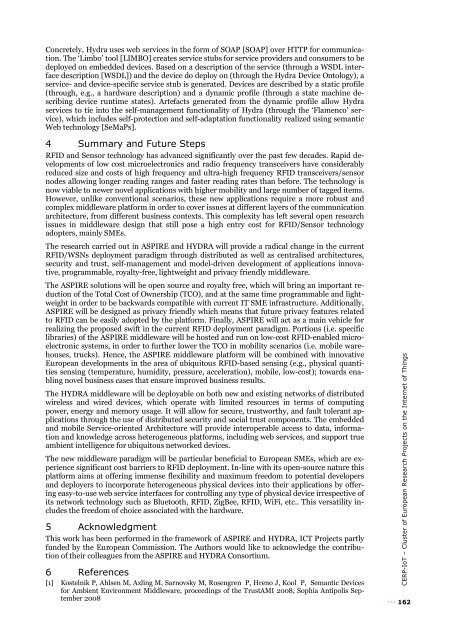Vision and Challenges for Realising the Internet of Things
Vision and Challenges for Realising the Internet of Things
Vision and Challenges for Realising the Internet of Things
You also want an ePaper? Increase the reach of your titles
YUMPU automatically turns print PDFs into web optimized ePapers that Google loves.
Concretely, Hydra uses web services in <strong>the</strong> <strong>for</strong>m <strong>of</strong> SOAP [SOAP] over HTTP <strong>for</strong> communication.<br />
The ‘Limbo’ tool [LIMBO] creates service stubs <strong>for</strong> service providers <strong>and</strong> consumers to be<br />
deployed on embedded devices. Based on a description <strong>of</strong> <strong>the</strong> service (through a WSDL interface<br />
description [WSDL]) <strong>and</strong> <strong>the</strong> device do deploy on (through <strong>the</strong> Hydra Device Ontology), a<br />
service- <strong>and</strong> device-specific service stub is generated. Devices are described by a static pr<strong>of</strong>ile<br />
(through, e.g., a hardware description) <strong>and</strong> a dynamic pr<strong>of</strong>ile (through a state machine describing<br />
device runtime states). Artefacts generated from <strong>the</strong> dynamic pr<strong>of</strong>ile allow Hydra<br />
services to tie into <strong>the</strong> self-management functionality <strong>of</strong> Hydra (through <strong>the</strong> ‘Flamenco’ service),<br />
which includes self-protection <strong>and</strong> self-adaptation functionality realized using semantic<br />
Web technology [SeMaPs].<br />
4 Summary <strong>and</strong> Future Steps<br />
RFID <strong>and</strong> Sensor technology has advanced significantly over <strong>the</strong> past few decades. Rapid developments<br />
<strong>of</strong> low cost microelectronics <strong>and</strong> radio frequency transceivers have considerably<br />
reduced size <strong>and</strong> costs <strong>of</strong> high frequency <strong>and</strong> ultra-high frequency RFID transceivers/sensor<br />
nodes allowing longer reading ranges <strong>and</strong> faster reading rates than be<strong>for</strong>e. The technology is<br />
now viable to newer novel applications with higher mobility <strong>and</strong> large number <strong>of</strong> tagged items.<br />
However, unlike conventional scenarios, <strong>the</strong>se new applications require a more robust <strong>and</strong><br />
complex middleware plat<strong>for</strong>m in order to cover issues at different layers <strong>of</strong> <strong>the</strong> communication<br />
architecture, from different business contexts. This complexity has left several open research<br />
issues in middleware design that still pose a high entry cost <strong>for</strong> RFID/Sensor technology<br />
adopters, mainly SMEs.<br />
The research carried out in ASPIRE <strong>and</strong> HYDRA will provide a radical change in <strong>the</strong> current<br />
RFID/WSNs deployment paradigm through distributed as well as centralised architectures,<br />
security <strong>and</strong> trust, self-management <strong>and</strong> model-driven development <strong>of</strong> applications innovative,<br />
programmable, royalty-free, lightweight <strong>and</strong> privacy friendly middleware.<br />
The ASPIRE solutions will be open source <strong>and</strong> royalty free, which will bring an important reduction<br />
<strong>of</strong> <strong>the</strong> Total Cost <strong>of</strong> Ownership (TCO), <strong>and</strong> at <strong>the</strong> same time programmable <strong>and</strong> lightweight<br />
in order to be backwards compatible with current IT SME infrastructure. Additionally,<br />
ASPIRE will be designed as privacy friendly which means that future privacy features related<br />
to RFID can be easily adopted by <strong>the</strong> plat<strong>for</strong>m. Finally, ASPIRE will act as a main vehicle <strong>for</strong><br />
realizing <strong>the</strong> proposed swift in <strong>the</strong> current RFID deployment paradigm. Portions (i.e. specific<br />
libraries) <strong>of</strong> <strong>the</strong> ASPIRE middleware will be hosted <strong>and</strong> run on low-cost RFID-enabled microelectronic<br />
systems, in order to fur<strong>the</strong>r lower <strong>the</strong> TCO in mobility scenarios (i.e. mobile warehouses,<br />
trucks). Hence, <strong>the</strong> ASPIRE middleware plat<strong>for</strong>m will be combined with innovative<br />
European developments in <strong>the</strong> area <strong>of</strong> ubiquitous RFID-based sensing (e.g., physical quantities<br />
sensing (temperature, humidity, pressure, acceleration), mobile, low-cost); towards enabling<br />
novel business cases that ensure improved business results.<br />
The HYDRA middleware will be deployable on both new <strong>and</strong> existing networks <strong>of</strong> distributed<br />
wireless <strong>and</strong> wired devices, which operate with limited resources in terms <strong>of</strong> computing<br />
power, energy <strong>and</strong> memory usage. It will allow <strong>for</strong> secure, trustworthy, <strong>and</strong> fault tolerant applications<br />
through <strong>the</strong> use <strong>of</strong> distributed security <strong>and</strong> social trust components. The embedded<br />
<strong>and</strong> mobile Service-oriented Architecture will provide interoperable access to data, in<strong>for</strong>mation<br />
<strong>and</strong> knowledge across heterogeneous plat<strong>for</strong>ms, including web services, <strong>and</strong> support true<br />
ambient intelligence <strong>for</strong> ubiquitous networked devices.<br />
The new middleware paradigm will be particular beneficial to European SMEs, which are experience<br />
significant cost barriers to RFID deployment. In-line with its open-source nature this<br />
plat<strong>for</strong>m aims at <strong>of</strong>fering immense flexibility <strong>and</strong> maximum freedom to potential developers<br />
<strong>and</strong> deployers to incorporate heterogeneous physical devices into <strong>the</strong>ir applications by <strong>of</strong>fering<br />
easy-to-use web service interfaces <strong>for</strong> controlling any type <strong>of</strong> physical device irrespective <strong>of</strong><br />
its network technology such as Bluetooth, RFID, ZigBee, RFID, WiFi, etc.. This versatility includes<br />
<strong>the</strong> freedom <strong>of</strong> choice associated with <strong>the</strong> hardware.<br />
5 Acknowledgment<br />
This work has been per<strong>for</strong>med in <strong>the</strong> framework <strong>of</strong> ASPIRE <strong>and</strong> HYDRA, ICT Projects partly<br />
funded by <strong>the</strong> European Commission. The Authors would like to acknowledge <strong>the</strong> contribution<br />
<strong>of</strong> <strong>the</strong>ir colleagues from <strong>the</strong> ASPIRE <strong>and</strong> HYDRA Consortium.<br />
6 References<br />
[1] Kostelnik P, Ahlsen M, Axling M, Sarnovsky M, Rosengren P, Hreno J, Kool P, Semantic Devices<br />
<strong>for</strong> Ambient Environment Middleware, proceedings <strong>of</strong> <strong>the</strong> TrustAMI 2008, Sophia Antipolis September<br />
2008<br />
CERP-IoT – Cluster <strong>of</strong> European Research Projects on <strong>the</strong> <strong>Internet</strong> <strong>of</strong> <strong>Things</strong><br />
162
















